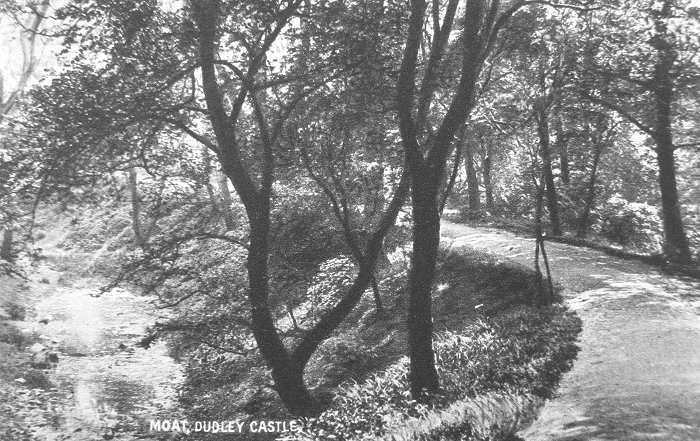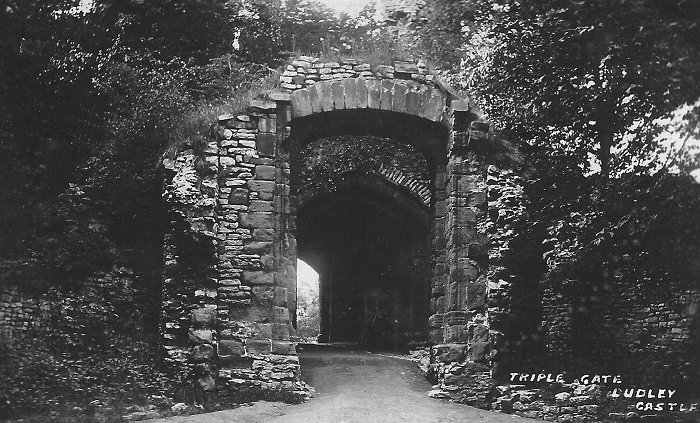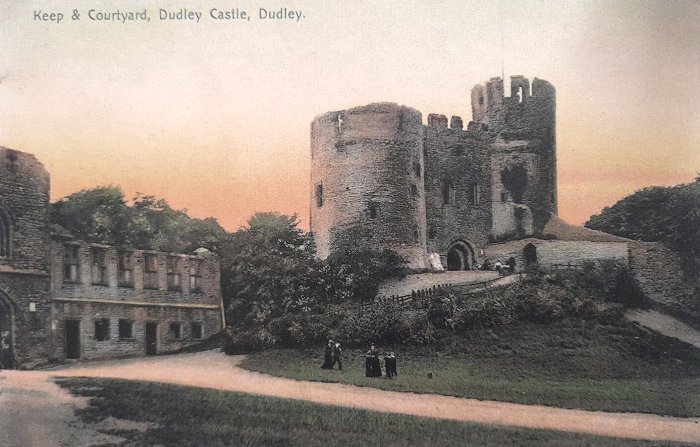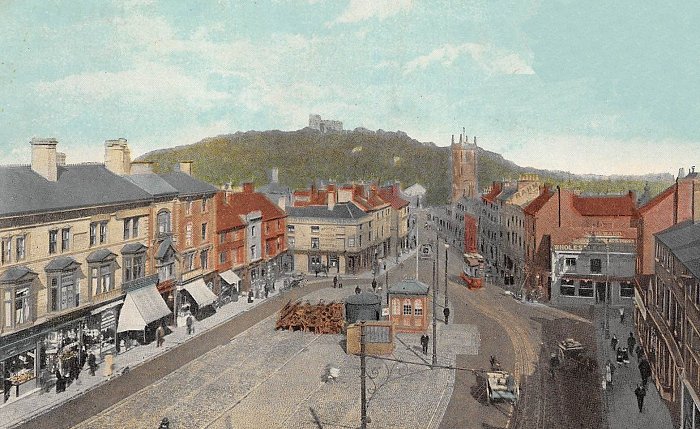| The Ruling Families and Dudley Castle The original Dudley Castle, a
simple wooden motte and bailey, constructed in 1070 by
Ansculf de Picquigny, was rebuilt in stone in the 12th
century. Ansculf de Picquigny was succeeded by his son,
William Fitz-Ansculf, who in turn was succeeded in the
12th century by Fulk Paganel who possibly married
Fitz-Ansculf’s daughter, Beatrice, but there is no
direct evidence of this.
The Paganels built the first stone
castle on the site. During the civil war between Matilda
and King Stephen, it was strong enough to withstand a
siege in 1138 by the forces of King Stephen, but when
Gervase Paganel took part in the failed rebellion
against King Henry II in 1173, which lasted 18 months,
the castle, along with about twenty others was
demolished by order of the king. During the rebellion,
many towns were destroyed and a large number of people
lost their lives. In 1165 Gervase, founded Dudley
Priory.
In 1194, Gervase Paganel was
succeeded by his nephew, Ralph de Somery, who was the
son of John de Somery and his wife Hawise, sister and
heir of Gervase Paganel. Ralph did not get full
ownership of the estate until the death of his mother in
1208, who had inherited some of the land herself.
In about 1205, Ralph swapped land
he held at Wolverhampton with King John, to obtain
estates at Kingswinford, including Pensnett Chase which
was used by the Lords of Dudley as a hunting ground and
later proved to be a rich source of coal and other
minerals.
Ralph, who died in 1210, married
Margaret le Gras, niece of William, Earl of Pembroke and
had three sons, Ralph, William Percival and Roger, who
successively inherited the barony. Roger began
rebuilding the castle in 1262. When he died in 1272,
work on the castle was still underway and it was
completed by his son and successor, Roger 2nd, who took
an active part in the campaigns against the Welsh. He
died in 1291, when his son John was just 12 years old.
He was survived by his widow, Agnes, another son, Roger
and two daughters. In 1303, John de Somery took part in
the Scotch war and was presented with a knighthood in
1306. He continued to take part in the Scotch wars and
immediately after the battle of Bannockburn was summoned
to Newcastle to help in defending the north of England.
John was very unpopular with his
tenants and neighbours because of his arrogant, rude and
dictatorial way. He also extorted large sums of money
from them. It seems likely that because of this,
Nicholas de Somery, son of Robert de Somery and others
were accused of breaking into Dudley castle in 1321 and
removing £1,000 and goods worth £200. It is believed
that the castle had been completed by this time.
John de Somery was the first person
in his family to be summoned to Parliament as a baron.
He died without children on the 29th December, 1321 and
his estate, including the castle became the property of
his eldest sister Margaret, who married into the de
Sutton family. The Somery's often used the family name
Dudley.
|

Dudley Castle
gatehouse and keep, as seen in the late
1940s. |
At this time large amounts of
building work took place at the castle, including a
barbican to the outer gatehouse and chapel. Parts of the
castle that were built around this time, still survive.
The keep, which was built on the Norman motte,
consisting of core of limestone rubble encased in clay,
had four drum towers, one on each corner, 9.8 metres in
diameter.
Most of the main gatehouse dates
from the 13th century. The double gateway with two
portcullises was constructed at this time. The barbican
was added to the outside of the gatehouse and the whole
structure became known as the 'Triple Gate'. It was
originally connected to the keep by a thick curtain
wall. When built, it had three floors with machinery for
operating the portcullises on the first floor and a
guard room on the second floor. Above the guard room
were the battlements.
|

From an old postcard. |
|

From an old postcard. |
John and Margaret de Sutton were
only in possession of Dudley castle for a few years.
John was accused of being involved in Thomas Earl of
Lancaster’s rebellion against King Edward II and was
imprisoned in the Tower of London and forced to give up
his right and interest in Dudley Castle, the town of
Dudley and the manor of Sedgley, to Hugh le Dispenser, a
favourite of the king.
In January 1327 the king was ousted
by his wife Isabella and her lover Roger Mortimer. Later
that year, the castle was returned to John and Margaret.
Their son, Sir John de Sutton 2nd,
born in 1310, became the first Baron Sutton of Dudley.
He married Isabella, daughter of John de Cherleton, Lord
of Powis. It seems that John de Sutton mortgaged the
castle to John de Cherleton, to whom he owed £3,000.
In 1330 to 1331, a number of people
were summoned before the King’s Bench, including William
le Fisshere, charged with besieging Dudley Castle. They
besieged the castle for two days and assaulted John de
Cherleton. A similar thing took place again in 1331 when
the castle was besieged and items were taken away. The
besiegers were led by Joan de Botetourt, daughter of
Roger de Somery and sister of Margaret de Sutton.
John de Sutton had recovered the
castle by 1337. On his death in 1359, the castle and his
estate became the property of Isabella, until she died
in 1397, when it was handed down to her great grandson,
John de Sutton 3rd, who had been born in 1339. John the
3rd married twice, first on the 25th December 1357 to
Katherine de Stafford, then after her death in 1361 he
married Joan, daughter of Sir John de Clinton of
Coleshill.
|

Another view of the
castle gateway. Also from an old postcard. |
On the 6th December, 1361, John 3rd
and Katherine had a son, John 4th, who became the 3rd
Baron Sutton of Dudley. John 3rd died while his son was
still young and so 350 marks were paid to Sir Philip Le
Spencer to be John’s guardian and also to arrange a
marriage between his daughter Alice and John. Alice died
in 1392 and then John married an unknown lady called
Joan, who died in April 1408. John 4th and Joan had a
son, John 5th, who became the 4th
Baron Sutton of Dudley and married Constance Blount,
daughter of Sir Walter le Blount of Barton, who was
killed at the Battle of Shrewsbury.
John 5th and Constance had several
children, John 6th, Thomas, Elizabeth and possibly
another son called Humphrey. John 5th died on the 29th
August, 1406 when John 6th was six years old.
Constance’s mother Sancha de Ayala took custody of him
and was granted his estates.

From an old postcard.
The Growth of the Town
Although the castle played a large
part in the town’s history, the town itself developed
entirely to the south of the castle, possibly as one
long street, where the High Street now stands, between
the churches of St. Thomas and St. Edmund. As the
population increased, other streets appeared to the
south, east and west.
Little is known about the early
town, which would have been planned and developed by the
ruling family, possibly Gervase Paganel in the latter
half of the 12th century. An important part of life
there was the market, roughly in the middle of the
village. There were no shops at the time so that anyone
wishing to buy or sell items had to use the market. King
Street and Tower Street were built alongside and linked
by interconnecting streets with properties and land that
was rented from the ruling family. The layout possibly
follows the boundaries of the old ploughed arable fields
that were slowly disappearing as the town increased in
size.
Stone Street Square was originally
called the Horsepool because it was the site of a pool
that was fed from a spring at the back of the market
place, between Stone Street and Wolverhampton Street. It
was called the Horsepool because horses were watered
there.
The market place was mentioned in 1261 when Roger
de Somery sued Giles de Erdington, Dean of
Wolverhampton, for opening a rival market there. An
agreement was reached so that Dudley people could use it
free of charge.
In 1339 mention is made in a deed,
of a high market cross, standing at the northern end of
the market place.

A view of Dudley
market place at the turn of the 20th
century, showing the relationship between
the early town and the castle. From an old
postcard. |
The medieval market was mainly the
place where agricultural products were bought and sold,
but there were also some small metal working industries
in the locality, thanks to the plentiful supply of local
iron ore, coal and wood, so locally made metal goods
would also be available. By the late 13th century, iron
was smelted on the thickly wooded Pensnett Chase on the
southern side of the town, which like much of the
surrounding woodland was mainly used for deer hunting.
The area of land on the north eastern corner of the
town, to the east of the castle, stretching northwards
into Tipton, called the Coneygre (meaning rabbit warren)
was where the Barons bred large numbers of rabbits,
having received the right to use it for this purpose in
1247. Castle Hill was previously called Coneygre Hill.
In 1476 much of the town centre,
including the old wooden St. Edmund's Church, was
destroyed by fire, which would have quickly spread
through the half-timbered buildings with thatched roofs.
It is not known how far the fire spread.
Dudley soon grew into a flourishing
little town with an expanding population and a network
of trackways providing easy access to the surrounding
towns.
|